Hydrangea is a beautiful flower that every gardener loves to grow. It is considered one of the most popular flowering shrubs in the world and for a good reason.
They’re exquisite, they grow well in many parts of the United States, and they’re a fairly low-maintenance plant.
All that said, it’s important to know how to prune your hydrangeas properly if you want them to stay healthy and look their best.
If you’re new to pruning hydrangeas or want a refresher on how to do it right, this blog is for you!
We’ll walk through the different types of hydrangeas and how you should prune them and provide tips on when exactly you should do so.
What are Hydrangeas?

Hydrangeas are a group of flowering plants that belong to the genus Hydrangea. There are over 75 different species of Hydrangea, including what is commonly known as the mophead or snowball hydrangea.
Depending on the variety you choose, these plants can be either deciduous or evergreen. They’re known for their large, showy flower heads and colorful leaves, ranging from dark green to white to pink.
The Hydrangea will bloom from early summer until late fall, depending on where you live and how much sun your Hydrangea receives. They’re pretty easy to care for once established.
These plants prefer direct sunlight but will tolerate full sun and part shade exposure during the summer months before they start going dormant in the fall months.
Definition and Origin of Hydrangeas
Hydrangeas are an iconic, beautiful flower with a lot of history and significance. The name “hydrangea” is derived from the Greek words: hydros (water) and angos (jar).
The plant was initially named “hydrangea” because its flower resembles a water jug. Wild hydrangeas are native to Japan and are often called Ajisai.
The hydrangeas blossom during Japan’s rainy season (tsuyu) from June to July, turning the Meigetsuin Temple into a mystical and fragrant garden.
According to legend, this spectacular flowering began when an emperor gifted blue hydrangeas to a girl he loved in atonement for neglecting her.
The Japanese have appreciated the sweet scent and vibrant colors for centuries, but its history goes back much further.
Research shows that the plant first grew in North America 40-65 million years ago—back when dinosaurs roamed this continent!
The Hydrangea was unknown in Europe until it was brought there by a colonist from North America around 1736. in the modern day, hydrangeas can be found all over the world.
Appearance and Characteristics

Hydrangeas can be found in a wide range of colors, from pink to blue. The most common varieties are pink, blue, and purple, with some colors ranging from white to green to pink or red.
They are easily recognizable by their large, round flower heads that bloom in the summertime.
The flower clusters can be anywhere from two to eight inches in diameter and often have multiple layers of petals.
The hydrangea leaves are usually heart-shaped but can also be oval or round. Hydrangea plants generally grow between 3 and 5 feet tall, depending on the variety.
The most common types of hydrangeas are mophead, panicles, and lacecap varieties.
The mopheads have large flower heads that grow on stems, while the lacecaps have smaller ones that grow on branches.
Panicles, on the other hand, are small, round clusters of flowers that grow on stems.
It’s important to remember that not all hydrangea flowers bloom simultaneously; some varieties will bloom in early summer while others wait until early summer to fall.
Hydrangea Size Chart: How Big Do Hydrangeas Get?
Hydrangeas are known for their gorgeous blooms, which come in various colors and sizes. But what exactly is the average size of a hydrangea?
Hydrangeas can grow into huge bushes that tower over their neighbors and cast long shadows on your lawn. But it isn’t just the size of the plant that matters—it’s also how big each bloom gets!
So if you want to know how big hydrangeas get, we’ve got everything you need to know right here:
The average hydrangea size by year depends on its species and where it’s being grown.
Hydrangeas that grow in colder climates tend to be shorter than those grown in warmer temperatures simply because they have less time to grow before winter comes along, forcing them into dormancy.
Below is a Hydrangea size chart of hydrangea sizes to guide you to what to expect when growing this plant:
| Type of Hydrangea | Height | Width |
| Bigleaf Hydrangeas | 3 ft – 8 ft | 4 ft |
| Mophead Hydrangeas | 3 ft | 3 ft |
| Climbing Hydrangeas | 30 ft – 50 ft | 5 ft – 6 ft |
| Lacecap Hydrangeas | 6 ft | 6 ft |
| Mountain Hydrangeas | 2 ft – 4 ft | 4 ft |
| Oakleaf Hydrangeas | 3 ft – 12 ft | 3 ft – 12 ft |
| Panicled Hydrangeas | 3 ft – 20 ft | 6 ft – 8 ft |
| Smooth Hydrangeas | 3 ft – 10 ft | 6 ft |
6 Main Hydrangea Species
There are wide different varieties of Hydrangea, but only six types are considered the main types of hydrangeas.
1. Hydrangea Macrophylla (Bigleaf Hydrangea)

This is the most common species. It’s native to Asia but also found in North America, South America, and Europe. Hydrangea macrophylla is a deciduous shrub that can grow up to 10 feet tall with leaves that are usually between 5 and 12 inches long.
There are two types of Hydrangea macrophylla (Bigleaf):
Mophead – This is a common type of Big Leaf hydrangea. It has large, round flower heads that can reach up to 6 inches in diameter. The flowers are usually white or blue.
Lacecap – This type has smaller flower heads that usually measure 3 to 5 inches in diameter. The flowers are typically pink or purple.
2. Hydrangea Arborescens (Smooth)

This is deciduous foliage that can grow up to 8 feet tall. It has large leaves that are usually between 10 and 20 inches long. The flowers are generally white or pink and appear during the summer months of June and July.
3. Hydrangea Paniculata (Panicle Hydrangea)

This is a branchy deciduous shrub that can grow up to 6 feet tall with leaves that are usually between 3 and 6 inches long.
The flowers are typically creamy white. The dark green leaves turn a beautiful orange in the fall.
4. Hydrangea Quercifolia (Oakleaf Hydrangea)

Also known as PeeGee or hardy, Limelight varieties are the easiest to grow of all their kin.
They’re often referred to as “black thumb” shrubs because they can thrive even with minimal care from clueless gardeners!
5. Hydrangea Serrata (Mountain Hydrangea)

This is a smaller, more compact version of the big leaf hydrangea. It has smaller flowers and leaves than its larger counterpart—which grows in moist mountain valleys in Japan.
It’s a deciduous shrub that grows 2-4 feet tall and as wide, though harsh winters or pruning can reduce its size. Its leaves are ovate—with blunt tips and coarsely toothed edges—and dull green in color (up to 6 inches long).
Flowers are grouped in flattened clusters, with the outermost florets being sterile and the inner ones fertile. Hydrangea Serrata is sometimes called the “tea of heaven” because its leaves can be used to make sweet tea.
6. Hydrangea Anomala (Climbing Hydrangea)

It is a vivid green in the summer, with white flowers that bloom in mid-summer and yellow in fall color.
In winter, its exfoliating bark peels off to reveal orange underneath—an incredible sight! This vine can be used on brick or concrete walls, arbors, gazebos, or any other structure you wish to highlight.
This woody vine has an almost shrub-like appearance due to its lateral branches, which climb by twining, and aerial roots.
It thrives in forests or mountainsides where the soil is moist but well-drained—preferably near water sources such as rivers and streams.
Climbing hydrangea is slow to establish, but once it’s growing well and producing flowers, the plant stays healthy. It prefers rich soil with excellent drainage—it’ll grow in the sun or shade!
Once established 60-80 feet high (varieties vary), this natural vine makes a great addition to any garden ecosystem.
49 Different Types of Hydrangeas Bushes
There are many types of hydrangeas bushes that you can plant in your garden. Some varieties grow as bushes; others grow as vines. The most common types of Hydrangea include:
Types of Hydrangea for Sun
1. French Hydrangea
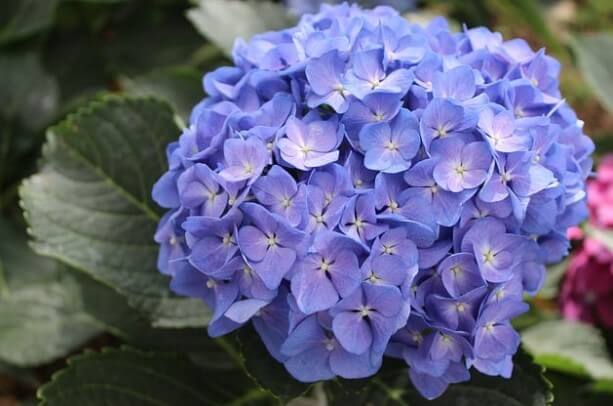
This deciduous shrub boasts clusters of large blue or pink flowers blooming in summer and autumn.
It belongs to the scientific name of hydrangea macrophylla and is native to Japan. It has a plant zone of 6 to 9 and thrives in direct sunlight.
2. Smooth Hydrangea

With the scientific name of hydrangea arborescens, this multi-stemmed shrub boasts its signature creamy white flowers.
Native to the eastern United States, It has a plant zone of 3 to 9 and thrives in dappled shade and full-on sunlight.
3. PeeGee Hydrangea

With the scientific name hydrangea paniculata, this shrub boasts white blooms that fade to a pink or purple tint as it ages.
It is native to southern and eastern China, Korea, Japan, and Russia and has a plant zone of 3 to 8. It thrives in partial shade to full-on sunlight
4. Annabelle Hydrangea

A landscaper’s favorite and with the scientific name of hydrangea arborescens, Annabelle hydrangea, is a type native to the Eastern United States and boasts large white flower heads that bloom from summer to winter.
It requires partial shade to full-on sunlight and has a plant zone of 3 to 8.
5. Oakleaf Hydrangea

With the scientific name of hydrangea quercifolia, oakleaf hydrangea gets its name for its leaves shaped like an oak leaf.
This type is native to the woodlands of the southern United States and has white flowers that eventually turn pink over time. It thrives in full-on sunlight and has a plant zone of 5 to 9.
6. Climbing Hydrangea

This climbing plant with the scientific name of hydrangea petiolaris has clusters of white flowers.
It is native to the woodlands of Japan, the Korean peninsula, and the Sakhalin island of easternmost Siberia in the Russian Far East.
It thrives in partial shade to full-on sunlight and has a plant zone of 4 to 8.
7. Gatsby Pink Hydrangea

Boasting big and beautiful cluster heads of flowers that turn from white to pink, this type with the scientific name of hydrangea quercifolia is native to North America.
It thrives in full shade, partial sunlight, full-on sunlight, and a plant zone of 5 to 9.
8. Bobo Hydrangea

With large white flowers blooming in the summer and turning pink over time, hydrangea paniculata is a strong native of southern and eastern China, Korea, Japan, and Russia.
It has a plant zone of 3 to 8 and thrives in partial shade to full-on sunlight.
9. Panicled Hydrangea

Also known as limelight hydrangeas, hydrangea paniculata is a type that is native to eastern China, Korea, Japan, and Russia, and It thrives in afternoon shade to full-on sunlight with a plant zone of 3 to 7.
10. Japanese Climbing Hydrangea

With the scientific name of hydrangea anomala, this Hydrangea boasts bright green leaves and beautiful white flowers that bloom in mid-summer.
As the name suggests, this type is native to the woodlands of Japan, the Himalayas, southern and central China, and northern Myanmar.
It thrives in partial shade to full-on sunlight and a plant zone of 4 to 8.
11. Hydrangea Nikko Blue Shrub

With flowers that range from blue to pink to purple to white and bearing the scientific name of hydrangea macrophylla, it is native to Japan and thrives in partial shade to full-on shade. It has a plant zone of 6 to 9.
Types of Hydrangeas for Shade
12. Big Daddy Hydrangea

As the name suggests, big daddy hydrangea boasts incredibly large blooms that determine its color with the type of soil used.
This hydrangea macrophylla has pink flowers in alkaline soils and blue flowers in acidic soils and thrives in partial shade to full-on shade.
It is native to Japan and has a plant zone of 6 to 9.
13. Blaumeise Hydrangea

Seen as one of the best blue lacecap hydrangeas, hydrangea macrophylla ‘Blaumeise’ has large blue flat flowers and thrives in partial shade to full-on shade.
This type is native to Japan and has a plant zone of 5 to 9.
14. Endless Summer Bloomstruck Hydrangea

With the ability to change colors depending on the soil pH, hydrangea macrophylla ‘Piihm-ii’ thrives in partial shade and is native to Japan.
It has a plant zone of 4 to 9.
15. Lady in Red Hydrangea

As the name suggests, this beautiful lacecap Hydrangea boasts clusters of red flower heads. With the scientific name hydrangea macrophylla, it is native to Japan.
It thrives in partial shade to full-on sun and has a plant zone of 6 to 9.
16. Firelight Hydrangea

With the scientific name of hydrangea paniculata, this type blooms creamy white flowers that turn bright red as it ages.
It is native to southern and eastern China, Korea, Japan, and Russia and thrives in full-on shade, partial sunlight to the full-on sun. It has a plant zone of 3 to 7.
17. Seaside Serenade Bar Harbor Hydrangea

Hydrangea arborescens’ SMHAMWM’ is the compact form of Annabelle hydrangea that boasts big white clusters of flower heads.
It is native to New York, west Florida, Iowa, Missouri, Oklahoma, and Louisiana and thrives in partial shade to full-on sunlight with a plant zone of 3 to 9.
18. Lilacina Hydrangea

With the scientific name of hydrangea macrophylla Lilacina, this type boasts mauve or blue lacecap flower heads and is native to the United Kingdom.
It thrives in light to open shade and a plant zone of 6 to 9.
19. White Wedding Hydrangea

As the name suggests, hydrangea paniculata ‘LeeP1’ is native to the south and eastern parts of China, as well as to Korea, Japan, and eastern Russia, and boasts beautiful clean white flower clusters that look like small pillows.
It thrives in partial shade to full-on sunlight and a plant zone of 4 to 9.
20. Tara Hydrangea

The white flowers of hydrangea quercifolia ‘Tara’ blooms beautifully from summer to fall and are native to the southeastern United States.
It has a plant zone of 5 to 9 and thrives in partial shade to full-on sunlight.
Types of Climbing Hydrangeas
21. Hydrangea Anomala Subsp. Petiolaris
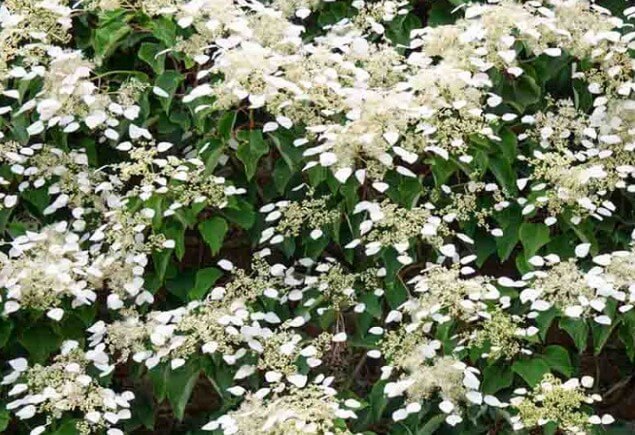
This climbing plant with the scientific name of hydrangea petiolaris has clusters of white flowers and is native to the woodlands of Japan, Sakhalin, Korea, and Taiwan.
It thrives in partial shade to full-on sunlight and has a plant zone of 4 to 8.
22. Miranda Hydrangea

Hydrangea anomala subsp. petiolaris ‘Miranda’ is a climbing hydrangea that thrives in partial to full shade and is native to the Himalayas and China.
It has a plant zone of 4 to 8.
23. Silver Lining Hydrangea
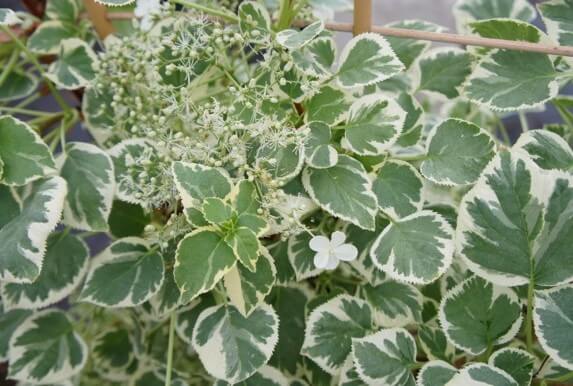
The flowers of Hydrangea anomala subsp. petiolaris ‘Silver Lining’ blooms from early summer to mid-summer, and its almost heart-shaped leaves boast a variety of beautiful shades of green.
This type is native to the Himalayas and China, and it thrives in partial and full shade to full-on sunlight and has a plant zone of 5 to 8.
24. Flying Saucer Hydrangea

Hydrangea anomala subsp. petiolaris’ Flying Saucer’ is a climbing hydrangea that thrives in partial shade to full sunlight.
This type is native to eastern and southern China, Japan, Sakhalin, and Kuril Islands and has a plant zone of 3 to 8.
25. Crug Coral Hydrangea

The flowers of Hydrangea anomala subsp. glabra ‘Crug Coral’ blooms a pale red in the summer and turns pink and cream over time.
This type has a plant zone of 7 to 9 and is native to India. It thrives in partial shade to full-on sunlight.
26. Hydrangea Serratifolia

The serrated leaves hydrangea serrata ‘Golden Sunlight’ is a beautiful evergreen color, and it thrives in partial shade in a plant zone of 6 to 9.
This type is native to Chile and Argentina.
27. Hydrangea Seemannii

Native to the Sierra Madre Occidental in Mexico and the United Kingdom, hydrangea seemannii thrives in partial and full shade and a plant zone of 7.
Other Hydrangea Types
28. Mophead Hydrangeas

With the scientific name of hydrangea macrophylla, mopheads come in two sizes: small flower clusters and large flower clusters.
This Hydrangea is native to Japan and thrives in light shade to full-on sunlight and in a plant zone of 5 to 9.
29. Lacecap Hydrangeas

Belonging to hydrangea macrophylla boasts large clusters of flower heads of pink or blue flowers that bloom in summer and autumn and thrives in afternoon shade to morning sunlight.
This type is native to Japan in a plant zone of 3 to 9.
30. Mountain Hydrangea

Hydrangea serrata is native to Korea and Japan and is considered the least common mophead.
It thrives in full-on sunlight and has a plant zone of 6 to 9.
31. Big-leaved Hydrangea

With the ability to change colors depending on the soil pH, hydrangea macrophylla ‘Piihm-ii’ thrives in partial shade and is native to Japan.
It has a plant zone of 4 to 9.
32. Blushing Bride Hydrangea

Hydrangea macrophylla ‘Blushing Bride’ is native to Japan and is a compact hydrangea with beautiful pure white flowers that bloom in early spring.
It thrives in partial shade to full-on sunlight in a plant zone of 4 to 9.
33. Tree Hydrangea

As the name suggests, this hydrangea paniculata grows to resemble a small tree and is native to New York, Massachusetts, west Illinois, west Missouri, south Louisiana, south Florida, Kansas, and Oklahoma.
It thrives in full-on sunlight in a plant zone of 5 to 8.
34. Limelight Hydrangea

Hydrangea paniculata ‘Limelight’ is native to southern and eastern China, Korea, Japan, and Sakhalin Island in Russia.
It boasts a beautiful variety, with huge pale green flowers that bloom each summer that slowly turn to soft white, cream, and pink in the fall.
It thrives in partial to full-on sunlight and has a plant zone of 3 to 9.
35. Little Lime Panicle Hydrangea

The smaller version of the limelight, hydrangea paniculata ‘Jane,’ thrives in partial to full-on sunlight and is native to southern and eastern China, Korea, Japan, and Russia in a plant zone of 3 to 8.
36. White Hydrangea Incrediball

Native to North America, hydrangea arborescens’ Abetwo’ Incrediball boasts white flowers that bloom in mid-summer and look like enormous snowballs.
It thrives in partial to full-on sunlight and has a plant zone of 3 to 8.
37. Mountain Hydrangea Bluebird

Belonging to the hydrangea serrata group, this type is native to Japan and Korea. It thrives in partial shade to partial and full-on sunlight in a plant zone of 6 to 9.
38. Oakleaf Hydrangea Sike’s Dwarf
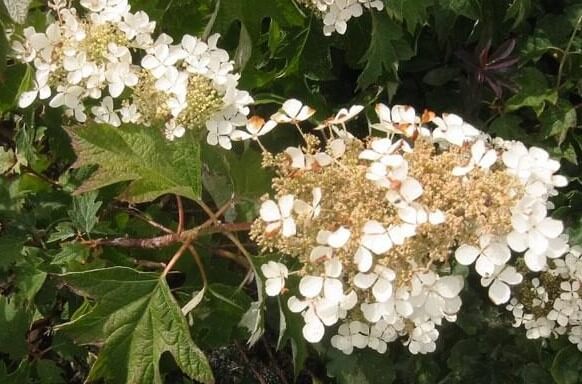
The hydrangea quercifolia ‘Sike’s Dwarf’ is the compact version of the oakleaf hydrangea and thrives in partial and full-on sunlight in a plant zone of 5 to 9.
This type is native to Georgia, Florida, and Louisiana.
39. Hydrangea Paniculata Dharuma

The ovate leaves that turn yellow in autumn and domed creamy-white flowers of the hydrangea paniculata ‘Dharuma’ thrives in partial shade to full-on sunlight in a plant zone of 3.
This type is native to the United Kingdom.
40. Bigleaf Hydrangea Masja

Hydrangea macrophylla ‘Masja’ is a mophead hydrangea that produces red to purple flowers and has glossy dark green leaves. This type is native to Japan.
It requires partial shade to full-on sunlight and a plant zone of 6 to 9.
41. Bigleaf Hydrangea Charm

Hydrangea macrophylla ‘Charm’ thrives in partial shade to full-on sunlight and is native to Japan. It grows in a plant zone of 5 to 9.
42. Mophead Hydrangea Pia

A dwarf mophead hydrangea with small, rounded flower heads, hydrangea macrophylla ‘Pia’ is native to Japan.
It thrives in partial shade in a plant zone of 5 to 9.
43. Cityline Mars Hydrangea

Hydrangea macrophylla Cityline® Mars is native to Japan and has beautiful magenta and white flowers that bloom in summer.
It thrives in partial and full-on sunlight in a plant zone of 5 to 9.
44. Zinfin Doll Hydrangea

Hydrangea paniculata Zinfin Doll® is a beautiful hydrangea with many clusters of flower heads that bloom a pure white and then turn bright pink over time.
This type is native to Asia. It requires partial and full-on sunlight and a plant zone of 3 to 8.
45. Blue Deckle Hydrangea

Hydrangea serrata’ Blue Deckle’ is a lacecap hydrangea with frilly pink or blue flowers that bloom in autumn. This type is native to the United Kingdom.
It thrives in dappled and partial shade to the full-on sun in a plant zone of 6.
46. Eldorado Hydrangea
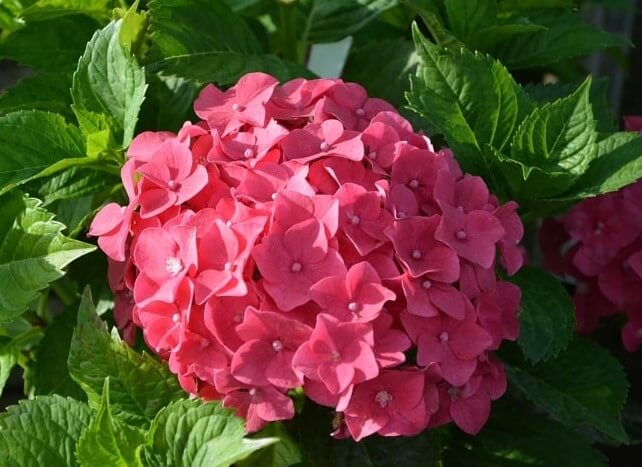
With its beautiful red flowers, hydrangea macrophylla ‘Eldorado’ is native to Japan and thrives in partial shade to the full-on sun in a plant zone of 6 to 9.
47. YOU&ME Together Hydrangea

Depending on the soil pH, the flowers of hydrangea macrophylla YOU&ME ‘Together’ will bloom either light pink in alkaline soils or light blue in acidic soils with Aluminium.
This type is native to Japan. It thrives in partial shade to the full-on sun in a plant zone of 6 to 9.
48. Madame Emile Mouillere Hydrangea
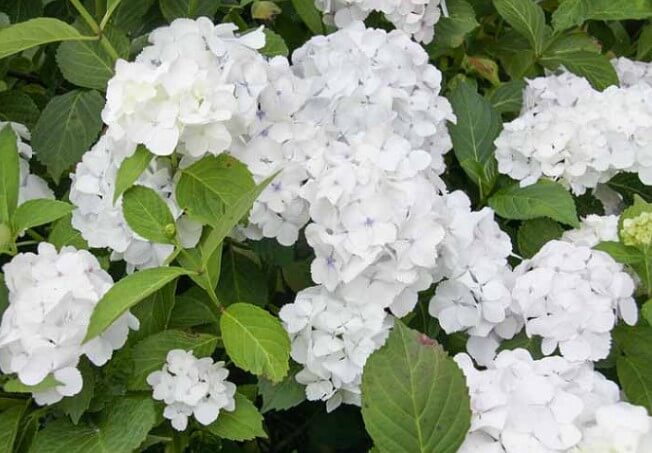
With its beautiful white clusters of flower heads, hydrangea macrophylla ‘Madame Emile Mouillere’ thrives in partial shade to the full-on sun in a plant zone of 5 to 9.
This type is native to Japan.
49. Miss Saori Hydrangea

Hydrangea macrophylla ‘Miss Saori’ is a tremendous dwarf hydrangea with tiered pink flowers that thrives in partial shade to full-on sun and a plant zone of 5 to 9.
This type is native to Japan.
Hydrangea Pruning Guide

Hydrangea pruning can be complicated because the plants tend to get branchy and lose shape. To keep your hydrangeas looking full and lush, you’ll want to prune them after they bloom.
In warmer climates, they might need a little help getting started with their first blooms in spring.
When To Prune Hydrangeas
Hydrangea pruning is best done in late winter or early spring before new growth begins. This will allow plenty of time for the plant to recover before it gets too hot outside in the summertime, when they need extra care and attention due to heat stress.
How To Prune Hydrangea Flowers
When it comes time to prune your hydrangeas, there are two ways you can do it. One by removing dead flowers only or all dead flower buds from the stems and any new growth that hasn’t bloomed yet (this includes those buds that may have formed on stems after last year’s blooming season).
How to Care for Your Hydrangeas
Here is a quick overview of how you should care for your hydrangeas:
Watering: Hydrangeas need regular watering during their growing season (spring through fall). The soil should always have a little moisture during this period; however, avoid getting water on the leaves, as moisture can damage them.
Fertilizing: Fertilizing is optional if you use good-quality soil when planting your hydrangeas. If you wish to fertilize your hydrangea plants, do so after they have flowered and before new growth begins in spring.
Pruning: Pruning is essential to taking care of your hydrangeas because it promotes healthy growth and prevents damage from pests such as Japanese beetles and spider mites.
Prune back any weak or dead branches by cutting off the entire stem at ground level with pruners or loppers.
Remove any stems that cross over other branches or the main stem of your hydrangea plant. This will help prevent disease and ensure that all the plant’s energy is directed toward growth.
How to Choose the Best Hydrangeas for A Garden
Hydrangeas are incredibly popular, and for a good reason. These beautiful flowering shrubs come in various shapes and sizes, and they can be grown to thrive in almost any climate.
Each type produces unique blooms—some have light pink petals with deeper pink centers, while others have pure white petals with blue or purple centers.
If you’re looking for a more constant supply of flowers throughout the year, choose a variety that blooms early in spring or late in fall so that you can enjoy them when other flowers aren’t in bloom yet or after their peak has passed.
If you’re looking for the best Hydrangea for your garden, here are some tips on how to choose:
Variety: There are over 300 cultivars of hydrangeas available today. The most common are blue and pink ones, but reds, purples, and whites are available.
The color of the flowers depends on which type of blue pigment is present in each cultivar’s leaves.
Size: Some hydrangeas grow as tall as 10 feet, while others only grow up to 4 feet high! You can choose compact varieties that will fit into a small space or large types if you want something more dramatic in your landscape design scheme.
Growth Habit: Some hydrangeas have rounded heads, while others have more open blooms resembling flat umbrellas (called panicle). The panicle blooms tend to be larger than those with round heads, so consider whether this will fit into your garden space before choosing this type.
Bloom Time: Some hydrangea varieties will bloom in late summer, while others will bloom in early spring or fall. The type of blue pigment is present in each cultivar’s leaves.
The Benefits of Growing Hydrangeas
Hydrangeas are popular types of flowering shrubs for home gardeners and landscapers alike. They have many benefits beyond their beauty, and here are some examples:
- They’re great for attracting butterflies and pollinators to your yard or garden.
- They also help keep pests away from your other plants because they produce a substance called hydrogen cyanamide that can kill insects.
- Hydrangeas are also drought-tolerant, so you don’t have to worry about them dying if there’s insufficient water around your house!
- They’re easy to grow, so you don’t need to be a professional gardener to keep them alive.
- Hydrangeas are also deficient in maintenance, so you don’t have to spend hours taking care of them daily.
- They’re also very durable and long-lasting. If you take proper care of them, they can live for many years without any problems.
- Hydrangeas can also be planted in most gardens because they’re very versatile and can grow in almost any soil.
- They’re also great for beginners because they only require a little care or maintenance.
- They are also great ornamental plants because they come in many beautiful colors and can add a lot of color to your garden.
- Their flowers can be dried and used in arrangements.
- Hydrangeas also make excellent cut flowers indoors and can be used as accent plants during special events.
Economic Importance
Hydrangeas are beautiful and versatile plants used for everything from the front to the back yard. They’re also an essential part of the economy.
Hydrangeas are a popular ornamental plant used in landscaping and gardening and for making decorations. They’re also used to make medicine, food, drinks, and even paper.
Frequently Asked Questions (FAQs) on Different Types of Hydrangeas
Hydrangeas are a popular choice for many gardeners. They’re beautiful, and they have an incredible ability to adapt to different environments and conditions.
But if you’re new to growing hydrangeas, knowing when or where to start can be challenging.
Don’t worry—we’ve got you covered. Here are several of the commonly asked questions about hydrangeas and how to prune them:
Q: How Can I Tell What Kind of Hydrangea I Have?
A: To help you identify what kind of hydrangeas you have the size and shape of the flower head are one way to tell what kind of Hydrangea you have.
If your plant has a large, rounded flower head, it is most likely a macrophylla. These are generally known as mophead or lacecap hydrangeas.
If your plant has a small, compact flower head, it is most likely a paniculata or panicle hydrangea. These are generally known as the Laceleaf or PeeGee hydrangeas.
Another way to tell what kind of Hydrangea you have is by looking at the leaves. The leaves on macrophylla plants are larger and more rounded than those on other types of hydrangeas, while the leaves on paniculata plants tend to be smaller than those on different hydrangeas.
Q: What Are The Old Fashioned Hydrangeas Called?
A: Old-fashioned hydrangeas have a rounded shape resembling a balloon or cone, making them easy to recognize among other flowering plants.
There is also a cultivar with an irregular shape: it tends to have long stems with clusters of flowers at various heights along each stem—it’s called ‘Grandiflora.’
Q: Should I Cut Back My Hydrangeas In The Fall?
A: It depends.
Most hydrangeas are “deciduous,” meaning their leaves fall in autumn and grow new leaves in the spring. If you’re starting to plant hydrangeas, you’ll want to prune them right after they drop their leaves—that way; you’ll be able to see what’s going on underneath.
Q: Do Hydrangeas Prefer Sun Or Shade?
A: Hydrangeas can take in sun and shade, but they prefer one. If your Hydrangea is under too much shade in your garden, try moving it into a sunnier spot.
On the other hand, if your Hydrangea is getting too much sun, try moving it into an area with more shade or consider planting a different type altogether.
Q: What Is the Most Common Type of Hydrangea?
A: The most common type is the mophead flower. This variety is also known as the “blue mop” and is characterized by large, round flowers that can be blue, pink, or white.
Q: How Many Different Varieties of Hydrangeas Are There?
A: There has yet to be a consensus on the number of different varieties of hydrangeas species. Some botanists claim 23; others contend that more than 80 varieties exist.
Q: What Are The Most Hardy Hydrangeas?
A: Hydrangea paniculata is the hardiest Hydrangea. It can grow in USDA zones 4 and higher, making it perfect for gardens in the Northern United States and Canada.
Q: What Type of Hydrangeas Bloom On Old Wood?
A: Oakleaf, mountain, bigleaf, and climbing hydrangeas are the types that bloom on old wood. These varieties can be pruned immediately after they finish blooming.
Q: What Type of Hydrangeas Bloom The Longest?
A: The soft Hydrangea blooms the longest. It can stay in bloom from late spring to early fall.
Q: What Type of Hydrangeas Blooms All Summer?
A: Endless Summer® Hydrangeas are a popular variety that blooms throughout the summer.
Q: What Type of Hydrangeas Can Take Full Sun?
A: Hydrangea paniculata can take full sun. It’s native to China and Japan, so that it can tolerate summer heat and humidity.
Q: What Type of Hydrangea Change Color?
A: Mophead hydrangeas and lacecap hydrangeas are the most common Hydrangea that changes color.
Q: What Type of Hydrangea Is Limelight?
A: Hydrangea paniculata’ Limelight’ is a popular variety of Hydrangea. It has large, creamy, fragrant white flowers that are very showy.
Q: What Type of Hydrangea Is Annabelle?
A: Smooth hydrangea cultivar Annabelle is a popular hydrangea with beautiful, large white flowers.
Q: What Type of Hydrangea Is Incrediball?
A: The cultivar of hydrangea arborescens is a type that is also known as incrediball.
Q: What Type of Hydrangeas Grow In Shade?
A: Oakleaf hydrangeas are the most well-known type that can grow in the shade.
Q: What Type of Hydrangeas Grow Tall?
A: Hydrangea paniculata varieties are the most well-known type that can grow tall.
Wrapping Up
Hydrangeas are beautiful flowering plants that come in various colors and sizes. They can grow in your local florist shop or garden center and make an excellent addition to any yard.
With proper care, these plants can last for years. However, there is one key thing that you need to do to keep your Hydrangea healthy: pruning.
Whether you’re a first-time hydrangea grower or a seasoned veteran, it’s important to know how to care for your plants.
The ideal time to prune hydrangeas is in the fall or early spring. Pruning hydrangeas too late in the season can damage them by forcing them into dormancy, so it’s best to start early in winter.
